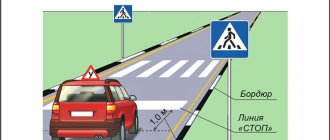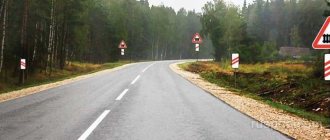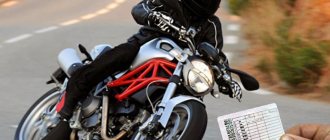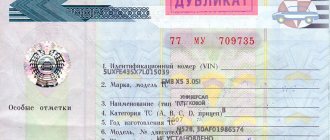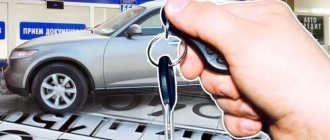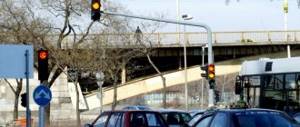Let's look at how to drive onto an overpass or how to correctly perform the "overpass" exercises when passing the driving test at the State Traffic Safety Inspectorate. The exercise is necessary to teach the cadet to stop on the rise and start moving from a place in the same direction. Entrance to the overpass includes:
- stopping on a climb with an incline of 8 to 12%;
- resumption of movement;
- travel on the upper platform;
- descent from the reverse side.
The engine should not stall while performing the exercise. Starting from the stop line at the end of the climb, the cadet can allow the car to slide down to a maximum of thirty centimeters.
Learning to drive a car also includes training in actions in various standard situations. One of these standard situations is the need to stop while driving uphill and then resume driving. If you mentally transfer what you practice on the racetrack to the city, then all the limitations associated with this exercise will become clear. Imagine that your car is moving uphill, and the car in front of you has stopped. You need to stop your car without hitting the one in front of you. A car also stops behind you. Therefore, when a car that has become an obstacle for you drives away, you must continue driving so as not to roll back to the car behind you. This gives rise to two limitations. Firstly, do not cross the stop line (do not collide with the car in front of you). Secondly, do not roll back (prevent a collision with a car standing behind you).
What is an overpass
An exercise that involves an overpass on a race track is called a slide. The process is to drive onto the first inclined part at low speed and stop there (on the rise, without driving to the top). The first stop zone is indicated by a “stop line” marked on the road surface. The overpass consists of 5 sections:
- initial horizontal (length of an average passenger car + 2 m);
- lift at an angle of 8-16% (car length + 2 m);
- a horizontal platform at the top of the overpass (approximately the length of a car);
- descent at an angle of 8-16% (car length + 2 m);
- horizontal finishing section (car length + 2 m).
One of the difficulties is starting (moving off) on an incline. During the maneuver, the car should not roll back far.
Important! The maximum permissible rollback is limited to a distance of 0.3 m from the rear bumper; an additional portable stand is located at this distance from the rear bumper.
The second “stop line” is drawn on the finishing horizontal section. When performing a maneuver, the driver is obliged to brake in the interval from 1 m to the line and no further than the forbidden line itself.
Mechanical climbing
Danger. Obviously, driving a car up a hill is much more difficult than driving on a flat road: the engine requires increased power and higher crankshaft speeds. In order to overcome the force of gravity and without a clear opinion about how and in what gear to drive uphill in a manual, drivers overclock the engine by pressing the gas pedal too hard. As a result, this often leads to wheels slipping. This effect mainly affects front-wheel drive cars, which is associated with the unloading of the front axle and a decrease in the grip of the wheels on the surface, especially slippery ones (clay, compacted snow, ice, etc.).
Another danger lies in hills and small slides. The driver sometimes does not see what is hidden by the next climb, but there may be a sharp turn, difficult obstacles (fallen trees, stones rolling down the slope, pedestrians, animals and much more) or holes.
Typical mistakes. Drivers often misjudge the steepness of the climb and choose the wrong gear (in the case of a manual transmission) or engine speed. It is almost impossible to climb a more or less serious slope, for example, only in fourth gear, so during the ascent it needs to be changed to a lower one. Therefore, driving uphill with a manual transmission inevitably involves some difficulty, since the clutch is disengaged during gear changes. As a result, the flow of power from the engine to the wheels is disrupted, causing the car's speed to drop sharply, and the inertia of movement up the slope is too small to help the car actively move up.
Sometimes on narrow country roads, moreover, with a dangerous shoulder, you have to climb uphill close to the center line of the roadway. This is fraught with a head-on collision at the top, especially if the oncoming car was also moving out of its lane.
Correct execution algorithm
Step-by-step instructions for checking in correctly the first time include the following points:
- Before completing the task, the driver must drive to the starting line and stop.
- The exercise begins after a signal from the traffic police officer taking the exam on the overpass.
- At low speed we approach the “Stop” line, located on the rise. It is strictly unacceptable to run over or cross the strip; there should not even be the edge of the bumper above it. It is preferable to stop at a short distance from the line, up to half a meter.
- To stop correctly, we depress the clutch and brake pedal on the mechanics. It is important to do this at the same time, since driving onto an overpass is most often required in a car with a manual transmission. We also pull the handbrake towards us. Without releasing the pedals, switch to the neutral position with the gearshift lever. Release the previously depressed pedals.
- The next stage involves starting up. According to the instructions, the driver is required to depress the clutch and shift the gear stick to first gear. We take the handbrake lever, press the button on it and slightly raise the engine speed to the level of 2000-2500 rpm.
- Without changing the position of the accelerator pedal, smoothly raise your foot from the clutch according to the instructions to the level where rotation is captured (about the middle of the pedal stroke).
- When the clutch is engaged, the driver will feel a drop in engine speed to approximately 1500 rpm, which will serve as a signal to release the handbrake and add gas slightly. After such exercises on the overpass, the car will go up.
- When passing the license, the driver drives through the upper horizontal area and at low speed goes down, where the second “stop line” is indicated.
Before the finish mark, the driver must stop and put the car on the handbrake. Only after this do we turn off the engine. Not everyone is able to pass it the first time, as mistakes happen during the implementation process.
Algorithm for working hands and feet
transmissionRussianeditUkrainianedit
Solution in practice, how to get started correctly.
- We get into the car, assess the surrounding situation so that when we start driving we don’t hit nearby cars or other obstacles;
- Be sure to buckle up. We follow traffic rules;
- We put the car on the handbrake; if it does not work or does not hold well, we ask an experienced friend to drive the car to the nearest car service center, spending less than a thousand rubles, you will save much more in case of an accidental slip when starting to drive uphill.
- We depress the clutch with our left foot and move the gearbox from the set gear to neutral.
- We start the engine and let it warm up for a few minutes.
- Depress the clutch.
- We engage first gear.
- Slowly release the clutch, the engine speed should decrease, the car vibrates slightly, at the same time lightly press the gas pedal. At the middle of their stroke, both pedals should be in approximately the same position.
- The car should start moving. Without releasing the clutch, drive for a few meters.
- Smoothly, fully release the clutch.
- After this, you can apply gas to switch to the next gear.
If you did not manage to do this the first time, do not be discouraged, the main thing here is training, calmness, smoothness and synchronization of movements.
When training how to get started correctly, you need to repeat this exercise, without starting the engine, until you achieve one hundred percent successful start of the car.
Solving potential problems when performing slides
When performing operations on site, it is necessary to be as focused as possible to minimize possible control errors. This can be achieved after long training and careful study of the theory. Tips for beginners:
- Even if the car stalls while performing the manipulations, you can restart the engine and complete the exercise. There is no penalty for two such mistakes. After the third time, the driver will be disqualified from passing the driving test.
- You should not use the pedal exclusively for the brake, as there will not be enough time to fix the car in the desired position. The rear bumper usually knocks down one triangle during a rollback. In such a situation, competent handbrake operation helps out. Errors are practically eliminated.
- When the driver feels at the start that the car is starting to roll back, it is important to quickly press the brake pedal and fix its position with the handbrake.
- The driver can stand at a greater distance from the second “stop line”, after which it is allowed to move to the first stage and drive a few centimeters forward.
It is preferable to choose a warm time of year for renting. Winter weather can make the exam more difficult. During cool periods, we recommend warming up the engine well in advance so that it runs smoothly and does not stall on an overpass at the wrong moment.
Performing a slide or overpass exercise on a race track
How to easily learn traffic rules for women and men in order to pass the exam accurately
One of the most difficult exercises on the race track when passing the exam is the overpass. The overpass element, compared to others, requires mandatory preparation. Having understood the principle of its passage and being well prepared, this exercise will not be difficult to perform correctly.
The overpass element at the autodrome is a hill with a smooth ascent and descent. Before the lift, a stop line is drawn - it is the immediate beginning of the exercise. Also on the rise, at a distance of about 1 meter, there is a second stop line, in front of which you must stop. And the last 3 stop line is drawn after leaving it - it is the stopping place after completing the overpass.
How to perform a flyover?
The essence of this exercise is to correctly drive along it, stopping and starting from the place where the second stop line is marked when going up the hill. It is in this place that the stand is placed at the rear at a distance of about 30 cm from the car in order to clearly capture the moment of correct starting from a place on a hill, without rolling back.
The complex flyover exercise should be performed in stages in the following order:
- Start. You must drive up to the stop line posted in front of the overpass. You need to move away after receiving the appropriate signal.
- The movement begins. At this stage, you need to start moving and drive to the stop sign, which is indicated on the rise. When stopping, you need to depress the clutch without releasing the brake pedal, apply the handbrake and release the clutch and brake pedals.
- Pulling away. Before starting on an incline, you need to depress the clutch, engage first gear, then depress the gas pedal and bring the engine speed to 2800-3000 rpm. After this, begin to release the clutch pedal and wait until the engine speed drops to 1200. Then, without removing your feet from the gas and clutch, release the handbrake #8212; the car will begin to move forward.
- Stop. Continue driving from the stop sign on the hill to the descent from the overpass. Stop after exiting it and stop the car also before the Stop line.
If the exercise was completed without any comments, then it is counted and considered completed.
Common Difficulties
Very often, while performing the slide exercise on the race track, cadets make the same type of mistakes. They mainly arise due to poor preparation and honing of skills.
The following errors occur:
- Mistake 1: Running a stop sign or not stopping for one.
- Error 2. Rolled down the hill. Solution: most likely the gas pedal was not depressed enough and the number of revolutions was not enough to climb the hill.
- Error 3. The car engine stalled on an incline. Solution: The engine will usually stall if the clutch has been dropped. You need to release more smoothly.
Penalty points
While the cadet is passing the overpass, the inspector evaluates the correctness of execution and assigns penalty points for any mistakes made. Each violation has its own points.
Penalty points on an overpass can be as follows:
Errors such as the engine stalling, the handbrake not being applied, or neutral gear not being engaged may not be recorded by the inspector. Therefore, in such cases, you need to worry less and continue #8212; start the engine and move away.
Finally
Most of the cadets’ difficulties in passing the exercise on the overpass arise from lack of experience. Before going to the exam, you need to bring the execution of the flyover to automaticity. In this case, there will be no mistakes in the exam.
Common mistakes on an overpass when starting on an uphill slope
Not everyone can drive a hill around the race track flawlessly. For such cases, the rules provide for acceptable errors. In addition to the engine stalling twice, the motorist is allowed to knock over the marking equipment. After the third repetition, the driver leaves the circuit empty-handed. The list of unacceptable mistakes (after at least one of them the driver is disqualified from taking the exam) is longer:
- the motorist hesitated for more than half a minute after receiving the signal to start moving;
- the “Stop” line is crossed or part of the bumper is located above it;
- the car drove beyond the established limits of the test site, marked with cones or white/yellow markings, as provided for in the delivery conditions;
- the car stood in front of the marking line at a distance greater than the control value;
- the driver left the test without permission or refused further passage;
- the car on a descent or ascent rolled back after the start to a distance of more than 0.3 m.
If possible, you need to get behind the wheel of a car that you have already had driving experience in.
Important! The instructor can provoke the driver, so the examinee is obliged to show maximum attention and not succumb to provocations, properly motivating his refusal.
Tips for passing the overpass
The main mistakes were listed above, but most often the tester makes mistakes in the following situations:
- Stopping behind the stop line, as well as a situation where the car was not stopped at all.
- During the ascent, the engine stalled.
- The car rolled down the hill.
- If you need to perform a maneuver, do it in advance, since the car should already approach the “hill” in a straight line. Otherwise, the front wheels on the elevated surface will not align correctly, and this risks ruining the entire exercise and receiving a penalty point.
- The machine should be stopped at the lifting point. The stop must be secured by raising the handbrake, otherwise you will not have time to move your foot to the other pedal and will slide down the hill.
- Be sure to secure the stop - after activating the handbrake, put the gearbox in neutral. Only after this can execution continue.
The main mistakes happen precisely at the stage when the car starts to move. Many experienced drivers will say that here you need to seize the moment, smoothly release the clutch, take the vehicle off the handbrake and complete the task. But for a beginner, such a description obviously will not seem simple - they have no experience and “seizing the moment” is quite difficult.
Conclusion
Comfortable shoes with soft soles help when checking in. Girls should not wear shoes with heels. We recommend being one of the first to go to the car, as some drivers can spoil the instructor’s mood. Don't forget the basic rules of the road, including wearing a seat belt.
Before driving, you should customize the interior for yourself in order to comfortably drive the car, for example, adjust the height and installation distance of the seat, adjust the steering wheel and mirrors. The success of the event depends not only on the psychological mood, but also on the physical condition and reaction speed. In this case, it is important to get a good night's sleep and rest.
#Newbie driver#Repair#Overpass
The tips will be useful to every car enthusiast.
- Try to pass the task on your group's first try. This is insurance against the teacher’s bad attitude, which can be spoiled by the poor knowledge of driving school newcomers.
- On the day of the exam, it is recommended to wear loose clothing and comfortable shoes. Women's shoes should not interfere with pedaling.
- Participation in recreational activities before the exam is approaching is prohibited. Try to get enough sleep and not take sedatives, even if there is anxiety. Medicines can impair attention, reduce reaction time, and reduce brain function.
For convenience, it is necessary to adjust the seats, rearview mirrors, and inspect the steering column. Necessary requirement: before you get behind the wheel of a car and start driving, immediately fasten your seat belt using a seat belt.
How to get started correctly
From the list of errors it is easy to understand that most of them are caused by the inability to move away, especially on an uphill slope. How to do it right:
- after stopping in front of the control line, press the clutch pedal all the way with your left foot;
- With your right hand, gently press on the gas so that the tachometer needle approaches the 3000 mark;
- slowly release the pressure on the clutch so that the device begins to show a value of 1000-1200, keep the pedal in this position;
- release the handbrake, the pedals are at the same level.
From this moment on, if everything is done correctly, the car will move.
Watch this video about the rules for starting and stopping on an overpass:
Rules for the delivery of the overpass in GAI 2021
Although the numbers are still serious. Thus, in Moscow since the beginning of the year, 442 accidents have occurred with drivers whose experience does not exceed two years. Moreover, 144 of them are graduates of capital driving schools. In these road incidents, 21 people were killed and 539 were injured. The most common accident caused by an inexperienced driver is a collision (297 accidents). The most common violation is incorrect choice of distance (95 accidents). But new motorists die on the roads most often due to driving into the oncoming lane.
We recommend reading: What should the salary be to start a young family alone without a husband?
Today, motorcyclists do not take a practical test in the city, and only ride on busy streets for the first time after receiving a license. Now they want to give motorcyclists the opportunity to take the exam in the city, but on roads and areas where the movement of other vehicles and pedestrians is limited.
Rules for the delivery of the overpass in GAI 2021
The State Duma is currently considering a proposal from the head of the State Traffic Safety Inspectorate, Mikhail Chernikov, who speaks of the need to conduct a theoretical exam every 10 years when replacing licenses. However, deputies do not support the initiative and argue that this innovation should become voluntary. For example, if a driver wants to test his knowledge when replacing his license, then the traffic police should not interfere with this. Does anybody want? This exercise can be performed in two ways: start with the handbrake or with the service brake.
After this, you need to answer all the questions in the training program on the disk and repeat the rules from the book again on the eve of the exam. During testing, you need to be extremely careful: be sure to read all the questions to the end, even if they seem familiar.
In conclusion
The above describes how to perform the “flyover” exercise correctly. It is worth noting that some “blots” may not be noticed during testing. For example, braking at a certain distance from the “Stop” line or briefly turning off the engine. You shouldn’t rely on chance; it’s better to complete all stages of the exam clearly and correctly.
To do this, you should practice thoroughly to bring the process to automaticity. Remember that the main mistakes are made due to poor driver training.
How to easily pass the traffic police license exam the first time
- Started moving without the inspector's command.
- Didn't fasten his seat belt.
- Exceeded the speed limit, or, conversely, drove too slowly.
- Forgot to turn on the turn signal.
- Did not give way to a pedestrian at a zebra crossing.
- Did not give way to a vehicle having priority.
- Parked in the wrong place.
- When approaching the intersection, he began to change lanes across a solid marking line.
- Stopped behind the stop line.
The conditions for passing exams in a driving school may be more stringent than in the traffic police. Internal exams are necessary for both the driving school and the students. The traffic police check driving schools for the percentage of people passing, and if this percentage is very low, the driving school may not renew its license. And a student who fails the task in a driving school will most likely fail the exams at the traffic police.
We recommend reading: Subsidy for Large Families 2021
Passing exams at the traffic police
- Be sure to get a good night's sleep the night before;
- do not take sedatives;
- manage your time correctly;
- choose comfortable clothes and shoes to feel confident;
- follow the culture of behavior - if questions arise, do not shout, but quietly call the examiner, do not look at the computers of other candidates, do not talk over each other.
For each mistake, the candidate receives an additional 5 questions from the same thematic block. That is, the maximum possible number of exam questions is 30. If the candidate makes a mistake in at least one additional question, or does not invest in the allotted extra time, the exam will not be taken.
